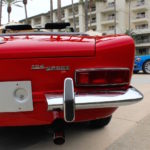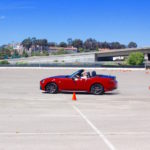The driver’s car is dying. It’s a woeful, frustrating truth, but it is our future reality. Certainly, there are multiple definitions of a driver’s car, but ultimately, they can all be boiled down to engagement. Sports cars will continue to get faster, but they’ll never become more visceral to drive. Enthusiasts live in a mystical time, where some automakers produce traditional driving experiences, while others attempt to reinvent the relationship between man and machine. Heck, some brands are doing both at once.
Before the sun sets on the manual transmission; before rear-wheel drive is dubbed “too dangerous” for modern transportation; before alternative energy powertrains saturate every corner of the market – we can still play out our automobile-personified dreams.
The 2017 Fiat 124 Spider has arrived in search of drivers; who wants to be found?
Miata v. Spider
Let’s just get this out of the way: yes, the Fiat 124 Spider is based on the new Mazda MX-5 Miata platform. However, there’s far more separating the two roadsters than an engine and body panels.
Of course, the pair has been intertwined longer than just the recent development process. Fiat’s 124 Sport Spider went into production in 1966 before making its way to the U.S. two years later. Its handsome design and soulful engineering made it an instant classic. To this day, Fiat has sold more Spider models in North America than any other nameplate. By the time it went out of production in 1985, Mazda had taken notice, and was already working on its interpretation that debuted in 1989. If sales figures were the only criteria by which to judge a vehicle, then the Miata clearly bests the Spider at almost 10 times the number produced. However, many would argue the Spider and Miata equally deserve their reputations as some of the best rear-wheel drive sports cars ever built.
Related: 2016 Mazda MX-5 Miata Review
While the Miata (now MX-5) has been in production since its inception, Fiat’s revival of the 124 Spider necessitated a lengthy development period that it was able to truncate by co-designing the latest MX-5. As a result, the two vehicles share the same chassis, general interior layout, drivetrain, and ragtop structure. As I learned, however – through presentation and hands-on experience – they are unique extensions of their respective brands when it comes to driving dynamics and fit-and-finish.
From a spec sheet, there are a few more significant points of differentiation. Compared to the 2016 Mazda MX-5 Miata, the 2017 Fiat 124 Spider is 5.0 inches longer, uses a turbocharged engine, develops more power and torque, mounts its motor further from the nose, has a larger trunk, delivers a different final drive ratio, includes noise cancellation in eight different spots, and offers more soft-touch materials. In terms of styling, the Fiat draws design elements from its 124 Sport Spider ancestor instead of a late 20th-century Mazda, but a peripheral glance could still confuse the two.
In broad-brush strokes, the Spider maintains its Italian soul while layering in affordable grand touring comfort.
Italian Soul
The Fiat that returned to the U.S. five years ago has been characterized by fun, alternative designs at affordable price points. While that’s helped the automaker sell hoards of 500 models, the Spider revival needed something more – something intangibly Italian.
At the heart of the 124 Spider is a 1.4-liter “Multiair” turbocharged four-cylinder producing 160 horsepower. Those familiar with FCA products will note that this engine has found its way under the hood of several vehicles, but it takes on a unique persona within the Spider. Plunging the accelerator pedal to the floor inspires the Italian powertrain to exhibit its raspy tune while 184 pound-feet of torque thrust the lightweight body forward. While maximum performance is available further into the powerband, initial shove is admirable for a turbocharged unit. From the first shift, I’ve fallen in love with the 124’s gearbox. Each throw is preposterously short and wonderfully satisfying. Complementing the ergonomic leather shift knob is a delightful “click” of each gear’s engagement point.
As speed builds, the roadster takes command of all senses. Top stowed (as it should be in such a car), the wind sails around the cabin, but thanks to Fiat’s noise reduction enhancements, it’s still possible to carry on a conversation. As your wrists rotate the leather-wrapped wheel, the Spider eagerly dives into each corner, channeling a clear message from the tires, through your forearms, straight to your dopamine sensors. The high continues even as you traverse jarring roads, where the 124 endures punishment that driver and passenger do not. Somehow, the compliant suspension doesn’t sacrifice handling performance either; while the MX-5 rolls its torso within corners, the Spider stays taut.
Then there’s the Abarth. Building upon the Spider’s aptitude for fun, the $28,195 Abarth adds Bilstein shock absorbers, anti-roll and shock tower braces, a mechanical limited-slip differential, and a sport mode that boosts torque, tweaks the pedal mapping, tunes the automatic transmission, and re-calibrates the steering for tail-happy maneuvers. Fiat was kind enough to stage a sizeable autocross course where the Abarth absolutely inhaled the short straights, hairpins, and tight switchbacks. With stability control switched off, the Abarth flung its rear and held a drift so easily that I was obliged to take every corner sideways.
Indeed, the 124 Spider has a soul, and those who believe in such things will certainly find it.
Design Dichotomy
When you finally tire of hastily rowing through the gears and chucking the roadster into each curve of the road, you begin to appreciate Fiat’s subtle refinements to the MX-5’s interior. Though the Spider’s performance is exceptional, it also aims to deliver grand touring comfort. At a starting figure of $24,995, don’t expect Bentley levels of luxury, but in lieu of Mazda’s devotion to weight reduction, Fiat imbues the cabin with soft touch materials and more premium trim panels. Even the entry-level Classica version feels special. Despite an impossible-to-decipher 3.0-inch infotainment module, the interior aesthetic is attractive, ergonomic, and functional.
Related: 2016 Audi TT-S Review
Upgrading to the $27,495 Lusso trim brings Mazda’s 7.0-inch infotainment system with a BMW iDrive-esque control knob and main function buttons, a backup camera, chrome exhaust ports, heated leather seats, a leatherette dash, and 17-inch wheels. Additionally, Fiat offers standalone safety and convenience packages for each trim level, meaning even an entry-level 124 can be equipped with top-shelf tech. It’s possible to option the Spider 10 grand above its starting figure, but even then it’s a bargain.
Unfortunately, while the 124’s cabin is superb, it’s exterior styling is questionable at best. Try as Fiat’s accented designers did, I wasn’t convinced that throwback cues like the rounded headlights, squared taillights, and front fascia had been well executed. Instead, Fiat seemed to shoot itself in the foot by bringing a gorgeous 1968 Spider Sport to display next to the 2017 model. The original’s clean lines and subtle flares simply do not translate successfully within the modern equivalent’s bodywork. Only the Abarth manages to escape harsh exterior scrutiny with its black hood, dark accents, and red trim; these elements combine to mitigate the Spider’s strange countenance.
Live, Drive, Repeat
I confess there’s ulterior motive attached to this review. Just like the new MX-5 Miata, I wanted to love Fiat’s 124 Spider. Both cars represent a counter-cultural move to design, develop, and produce enthusiast automobiles when fewer and fewer buyers seem to care for them. If the cars are good enough, I fantasize, the general populus may rediscover the joys of driving engagement. Though a massive shift in consumer behavior may be a foolish dream, at least Fiat and Mazda are doing their part.
The 2017 Spider is a truly great sports car that includes sufficient levels of comfort and convenience to attract both purists and contemporaries alike.
Highs:
- Firm yet compliant chassis
- Superb gearbox
- Generous torque
- Precise steering
Lows:
- Funky front end
- Faint in-dash display



























































